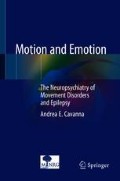Abstract
The seventeenth and eighteenth centuries saw the birth of the terms ‘neurology’ and ‘psychiatry’, the two components of the word ‘neuropsychiatry’. Despite the excess of a too literal approach to brain-behaviour relationships, Gall and Spurzheim’s phrenology should be recognised for mounting formal opposition to the mind-brain dualism that still prevailed in the first part of the nineteenth century and for establishing a (proto)scientific foundation for considering the brain as the organ of behaviour. The second half of the nineteenth century was dominated by Charcot’s school in France, whereas in Germany Griesinger expanded his predecessors’ work on the cerebral localisation of mental diseases and their symptoms. The first part of the twentieth century saw the development of Freud’s influential theories, which progressively shifted the focus of psychiatry from the brain to the unconscious. However the neuropsychiatric approach to brain-behaviour correlations did not disappear, thanks to the approach endorsed by Hughlings Jackson, von Economo, and Goldstein, among others.
Prediction is very difficult, especially if it’s about the future.
Unknown, attributed to Niels Bohr (1885–1962)
Access this chapter
Tax calculation will be finalised at checkout
Purchases are for personal use only
Suggested Reading
Books
Bennett MR, Hacker PMS. History of cognitive neuroscience. Chichester: Wiley-Blackwell; 2012.
Blackmore C. The mind machine. London: BBC Books; 1988.
Clarke E, Dewhurst K. An illustrated history of brain function. Berkeley: University of California Press; 1972.
Clifford Rose F, Bynum WF, editors. Historical aspects of the neurosciences. A Festschrift for Macdonald Critchley. New York: Raven Press; 1982.
Critchley M, Critchley EA. John Hughlings Jackson: father of English neurology. Oxford: Oxford University Press; 1998.
Draaisma D. Disturbances of the mind. Cambridge, MA: Cambridge University Press; 2009.
Finger S. Origins of neuroscience. New York: Oxford University Press; 1994.
Finger S. Minds behind the brain: a history of the pioneers and their discoveries. New York: Oxford University Press; 2000.
Glickstein M. Neuroscience: a historical introduction. Cambridge, MA: MIT Press; 2014.
Goetz CG. Charcot the clinician: the Tuesday lessons. New York: Raven Press; 1987.
Goetz CG, Bonduelle M, Gelfand T. Charcot: constructing neurology. New York: Oxford University Press; 1995.
Goldstein K. After effects of brain injuries in war. New York: Grune & Stratton; 1942.
Jackson T. The brain: an illustrated history of neuroscience. New York: Shelter Harbor; 2015.
Lee HSJ, editor. Dates in neurology: a chronological record of progress in neurology over the last millennium. New York: Parthenon; 2000.
Lyons W. Matters of the mind. Edinburgh: Edinburgh University Press; 2001.
Marshall LH, Magoun HW. Discoveries in the human brain. Totowa, NJ: Humana Press; 1998.
Martensen RL. The brain takes shape: an early history. New York: Oxford University Press; 2004.
Millon T. Masters of the mind: exploring the story of mental illness from ancient times to the new millennium. Hoboken, NJ: Wiley; 2004.
Spillane JD. The doctrine of the nerves: chapters in the history of neurology. Oxford: Oxford University Press; 1981.
Trimble MR. The soul in the brain: the cerebral basis of language, art, and belief. Baltimore, MD: Johns Hopkins University Press; 2007.
Trimble MR. Why humans like to cry: tragedy, evolution, and the brain. Oxford: Oxford University Press; 2012.
Trimble MR. The intentional brain: motion, emotion and the development of modern neuropsychiatry. Baltimore, MD: Johns Hopkins University Press; 2016.
Wickens AP. A history of the brain: from stone age surgery to modern neuroscience. London: Psychology Press; 2015.
Articles
Albright TD, Jessel TM, Kandel ER, Posner MI. Neural science: a century of progress and the mysteries that remain. Neuron. 2000;25:S1–55.
Arzy S, Danziger S. The science of neuropsychiatry: past, present, and future. J Neuropsychiatry Clin Neurosci. 2014;26:392–5.
Bennett MR. Development of the concept of mind. Aust N Z J Psychiatry. 2007;41:943–56.
Benson DF. The history of behavioral neurology. Neurol Clin. 1993;11:1–8.
Berrios GE, Markova IS. The concept of neuropsychiatry: a history overview. J Psychosom Res. 2002;53:629–38.
Dolan B. Soul searching: a brief history of the mind/body debate in the neurosciences. Neurosurg Focus. 2007;23:E2.
Kandel ER, Squire LR. Neuroscience: breaking down scientific barriers to the study of brain and mind. Science. 2000;290:1113–20.
Pandya SK. Understanding brain, mind and soul: contributions from neurology and neurosurgery. Mens Sana Monogr. 2011;9:129–49.
Papez JW. A proposed mechanism of emotion. Arch Neurol Psychiatr. 1937;38:725–43.
Parry Jones W. ‘Caesar of the Salpétrière’: J.-M. Charcot’s impact on psychological medicine in the 1880s. Bull R Coll Psychiatr. 1987;11:150–3.
Preston JL, Ritter RS, Hepler J. Neuroscience and the soul: competing explanations for the human experience. Cognition. 2013;127:31–7.
Santoro G, Wood MD, Merlo L, Anastasi GP, Tomasello F, Germanò A. The anatomic location of the soul from the heart, through the brain, to the whole body, and beyond: a journey through Western history, science, and philosophy. Neurosurgery. 2009;65:633–43.
Trimble M. The intentional brain: a short history of neuropsychiatry. CNS Spectr. 2016;21:223–9.
Author information
Authors and Affiliations
Rights and permissions
Copyright information
© 2018 Springer International Publishing AG, part of Springer Nature
About this chapter
Cite this chapter
Cavanna, A.E. (2018). Neuropsychiatry: The Story So Far. In: Motion and Emotion. Springer, Cham. https://doi.org/10.1007/978-3-319-89330-3_16
Download citation
DOI: https://doi.org/10.1007/978-3-319-89330-3_16
Published:
Publisher Name: Springer, Cham
Print ISBN: 978-3-319-89329-7
Online ISBN: 978-3-319-89330-3
eBook Packages: MedicineMedicine (R0)

